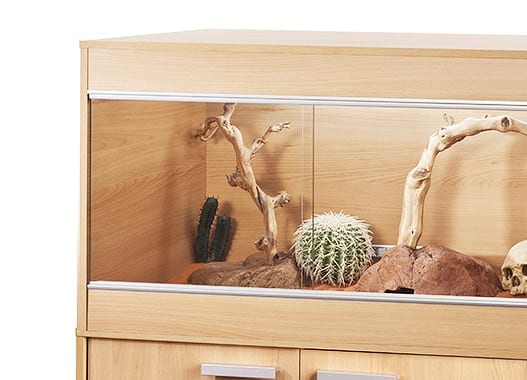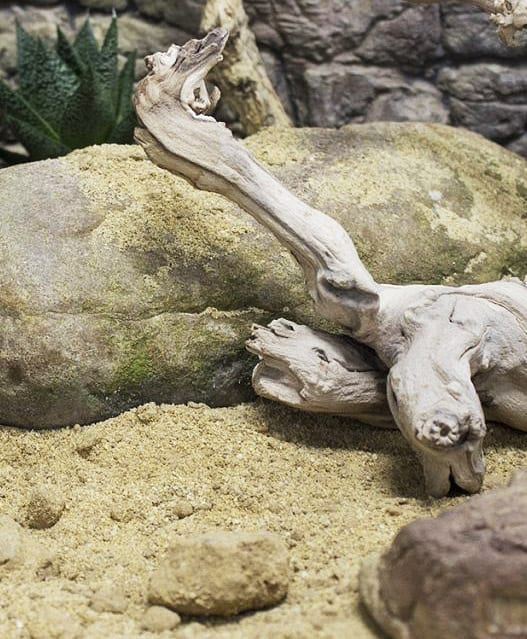Lepoard Geckos – Advanced Care
Leopard geckos are a good starter species for many people. They are resilient to a variety of conditions; however, it is all keepers’ duty to provide the best care possible. We outline various ways of providing their basic needs and some hints and tips on making their lives as enriched, healthy and long lived as possible. This guide splits their care requirements into six main categories – heating, lighting, diet, substrates, hides and to begin with, housing. As it’s important to consider any species wild natural history, in particular their biotope we have included a section so that the keeper can make an informed decision on the care they provide.
Housing
This species is mainly a ground dweller, whose climbing activities (in their wild counterparts) are generally limited to accessing their daytime hides – which are often nooks and crannies in walls and outcrops. They do not have the ability, like some other gecko species, to climb smooth surfaces. For this reason it isn’t a requirement to provide a particularly tall vivarium. That being said, many Captive Bred Leopard Geckos enjoying climbing around Stout branches and rocky surfaces. An adult will be fine in a vivarium as little as 60cm tall – if you plan to add climbing facilities. These sizes can be increased if a deep layer of substrate is planned (see more later). A minimum adult vivarium length should be regarded as around 90cm, if a larger vivarium is preferred always provide plenty of hiding places to allow for security. Babies and youngsters should be scaled appropriately in their housing. There are many styles of vivarium, and many materials they can be made from plastic, fibreglass and melamine all have their bonuses and their negatives.

Heating
There are many relationships with the choice of heat source and lighting. This is due to the wild conditions – the sun provides both. We must keep this in mind when choosing a heat source. In the wild the sun heats the ground during the day, Leopard geckos then come out after the sun as gone down and use the stored heat in the ground and rocks to warm their bellies. They can then go about their normal activities (feeding, breeding etc) during the dark hours of the day. They generally go back to their hides once they are too cold to maintain activity – this may be quite soon after sunset in the colder weather or at the most before sunrise. In captivity this can be achieved by overhead heating (if a light emitting bulb is used temperatures should be monitored during the colder months of the year) which will warm the surface below, a large piece of rock or slate can be added to absorb the heat for basking. This should be dug down to floor level with no loose substrate underneath to prevent accidents. All heaters of any kind should be controlled by a thermostat, for a non-light emitting heater a simple on/off model can be used – however, greater accuracy will be given by a pulse proportional thermostat. Any light emitting heater should be controlled by a dimming thermostat so there is no constant flashing on and off. Any choice of heater should be placed in the vivarium so there is a temperature gradient – there should be opportunity for the reptile to escape the heat. We aim for around 28-30C in the warm end and 20C in the cool end during the day, and at night the whole vivarium can drop to around 18-20C. If the keeper is concerned their house ambient temperature drops below this during the night there are thermostats that will control a day and night temperature – however, a light emitting heater is not recommended for use at night.
Lighting
As already discussed, in the wild Leopard gecko’s normal activity levels are after the sun has gone down, and finishes before the sun comes back up. They hide in deep crevices where light transmission is also very low. Many keepers provide no lighting at all for their Leopard geckos, others prefer to use some form of UVB light – We provide UVB for all of our Geckos.
The UVB light should be low powered (Zone 1), Arcadias T5 Shadedwellers are perfect for this purpose. This should be mounted next to the heat source and shadier areas provided to escape the light. Provide a photoperiod of at least 12 hours day to 12 hours night – this can be altered seasonally if a very natural pattern is preferred.
Substrates
Many forms of ground covering substrate have been tried for this species. Many keepers prefer to provide a more natural choice of a sand / soil based loose substrate others prefer sand or newspaper / carpet / lino. All have their good and bad points – but it’s fair to say that the worry of gut impaction is a topic that is fearlessly debated. We have used all methods and recommend ProRep LeoLife or Arcadia Earthmix Arid. For further reading see our advanced section on using various substrates.
Hides
Hides must be provided. These can be in the form of commercially available ones, but keep in mind if UVB is used that light transmission will be quite high – better to provide homemade deeper hides. This allows the reptile to regulate their exposure and choose the light level they prefer. There are many products that help with homemade hides such as Zoo Med Excavator Clay, we will add further guides in using these kinds of products in our advanced section. It’s important to remember that varying degrees of humidity will be required. In simpler set ups, with commercially available hides, there are products that lend themselves to humid hides such as Exo Terra’s Gecko Cave. Once these are packed with a moist substrate they will maintain a local high level of humidity. Of course dry hides must also be provided – again there are many to choose from. If the more advanced method appeals please take a look at our guide to creating more natural humidity creating hides.

Diet
Leopard geckos are insectivorous – this means they will need to be provided with a large selection of insects such as Crickets, Locusts, Cockroachs, Calciworms, Mealworms, Curly Wing Flies and Waxworms. Variety is the spice of life. When using commercially available live foods always keep in mind that their diet will need to be artificially supplemented. There are two main methods – one is to use supplement powders and the other is to gut load the live food (some keepers utilise both). Take a look at our guides for the use of supplements and gut loading in our general advice section. However it is worth noting that if UVB is used some keepers do not use vitamin D3 supplements – if this method is preferred there are supplements with no, or low vitamin D3. Always use a good quality multivitamin with D3 if UVB lighting is not provided.
Biotope
A good starting point is where this species occurs in the wild – it occurs in territories in India, Pakistan, Afghanistan and Iran. Most of these regions are very hot during the summer, with temperatures that can get as hot as 40-45C during the hottest part of the day, with cool to cold temperatures at night – varying through the range, but can be in single figures. When considering captive Leopard geckos it’s important to remember that both extremes of high and low temperatures will not be experienced by the wild animals as they will be hidden in their deep burrows. This species can become inactive during periods of cooler weather when evening and night temperatures are too low – some geographical regions have cold enough seasons for the leopard geckos to hibernate. Activity levels are dictated by the extreme high temperatures often experienced, their preferred peak activity temperature seems to be around 22-30C, which in the regions they live means coming out once the sun has gone down. It is noted in several papers that this species only ventures from their burrows once the sun has set, and they retreat back to their burrows before sun rises (presumably due to low temperatures as the night goes on). Humidity in the open air is low at around 20-30% and even seasonally higher in those regions experiencing a rainy season. The burrows themselves need to be deep nooks and crevices to protect them from the extremes of temperature the regions experience. It’s a very harsh environment and the deep burrows are also useful in protecting them from daytime predators. It is often hypothesised this species will “sunbathe” at the entrance of the burrow. This may be true, but possibly seasonally (the cooler months) and almost certainly early morning and evenings – each time this behaviour is exhibited it brings a risk of being predated by birds, mammals and other animals active during the daylight hours. Habitat is varied depending on (amongst other things) geographical region and human activity. They do not occur in true desert sand regions, but are often found in very arid regions – however, they can be found in forested areas. Away from human habitation they can be found in and around rocky outcrops. They are adaptable, in and around human habitation they can be found around agricultural areas and very urban areas living in deep crevices in walls and structures. They are colony animals, living in small groups – usually one male and several females. Males will not generally tolerate each other, unless juvenile. The colonies live their lives mainly in their burrow which is usually a complex series of tunnels and chambers – even a toilet chamber at the bottom of the burrow is utilised.
This guide is designed to be used in conjunction with the help and advice given during your personal consultation at Coast to Coast Exotics. Please allow at least an hour for us to cover the many details we feel you need to know for a successful lifelong time with your new reptile. Animal welfare is of utmost importance to us, and we encourage you to maintain contact with us throughout your geckos lifetime so we can help and keep you updated with new techniques and up to date information – even if it is just a regular visit to our ever expanding blogs, podcasts and written information guides. Don’t forget to sign up for our newsletter and join our busy Facebook page!
